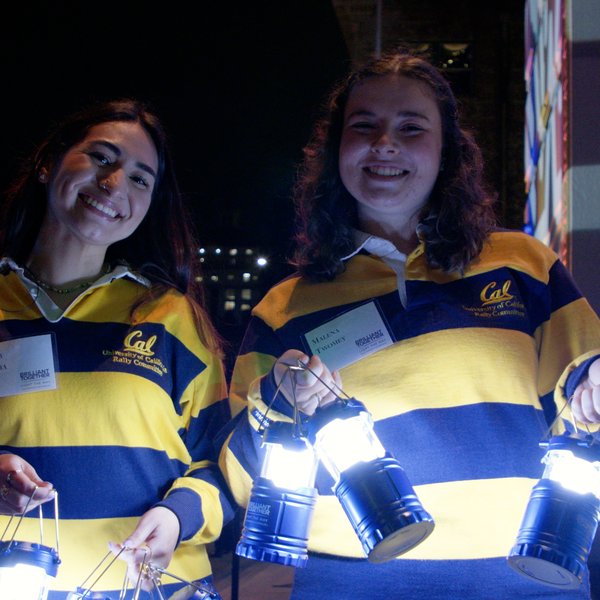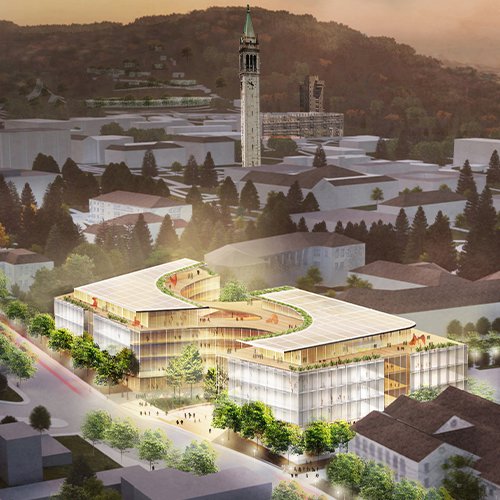Sometimes a river surges with a thunderous force. Trickles along like a gentle rain on a quiet night. Swirls against the current, or pulses to the unwavering beat of a drum.
Imagine Berkeley as a river. For 15 decades it has drawn people to its banks to nourish their minds and journey downstream toward new discoveries. Have you ever joined thousands of fans in a roaring “Go Bears!”? Were you among the last to leave the library, as the lights and sounds faded into darkness? Did you add your voice to the tradition of protest, demanding change to an unjust convention? As Daniel E. Koshland Jr., the late biochemist, once said, “The pavement of Sather Gate throbs to the beat of the campus, and few who enter through those portals escape the fascination of Berkeley.”
Our sesquicentennial could mark another bend in the river to which the force of history has propelled us. But what if it marked a rare chance to shape the river’s course, to steer Berkeley toward the university we want to become?

Salt Pond E9, Eden Landing Ecological Reserve, Hayward, Cali. Kite aerial photo by Charles C. Benton, professor emeritus of architecture.
As Chancellor Carol T. Christ discussed in this issue’s letter, Berkeley just completed a strategic plan that sets the course for the next 10 years. It preserves what we cherish most, while also adapting to the needs and interests of those we serve. The plan is anchored in three powerful visions:
- Empowering engaged thinkers and global citizens to change our world
- Focusing on the good: Innovative solutions for society’s great challenges
- Embracing the California spirit: Diverse, inclusive, entrepreneurial
Below we share stories of students, faculty, and programs that showcase a few strengths upon which the plan was built and that help bring these visions to life. Stories revealing the excellence and values — including innovation, community, nonconformity, and respect for the planet — that make Berkeley distinct.
Of course this is just the beginning. Join us as we sail in new directions.
Students often say Berkeley is a big place that’s hard to navigate. While the old Berkeley might have let students reach for the high bar on their own, the new one is saying, “We’ll help you get there.” Change is afoot to create clear, flexible pathways through the curriculum that will enable students to pursue multiple passions, whether they fall neatly into one field or cut across several. We are also expanding programs that help students flourish outside of the classroom. The new data science major and Berkeley Connect, a mentoring program, exemplify how we are reimagining the undergraduate experience.
Data science education buzzing at Berkeley
Senior Eleanor Fleming ’19, who loved French, history, and English in high school, had not been exposed to the tech world when she started at Cal. Eager to try something different, she took classes in computer science and cognitive science and became curious about how the two disciplines intersect.
Her timing was spot on. A team had formed to explore the possibility of a new major in data science — and she jumped at the chance to help build something from the ground up. “I got to talk to all these amazing students and professors who were using data science in their respective fields,” she says. “That was my aha moment: If you have a baseline understanding of data science, you can explore many different avenues without ever feeling like you’re veering off course.”
Jump forward, and Fleming is not the only one having an aha moment. Developed in response to intense demand for graduates equipped to work in a rapidly evolving digital world, the new B.A. in data science is quickly becoming one of Berkeley’s most popular majors. The first class of nine graduated in December, approximately 100 are expected to graduate this spring, and nearly 1,200 students have already filed pre-declarations. At a celebration for the first graduates, David Culler, interim dean of data sciences, said, “I hope you realize just how courageous you are."
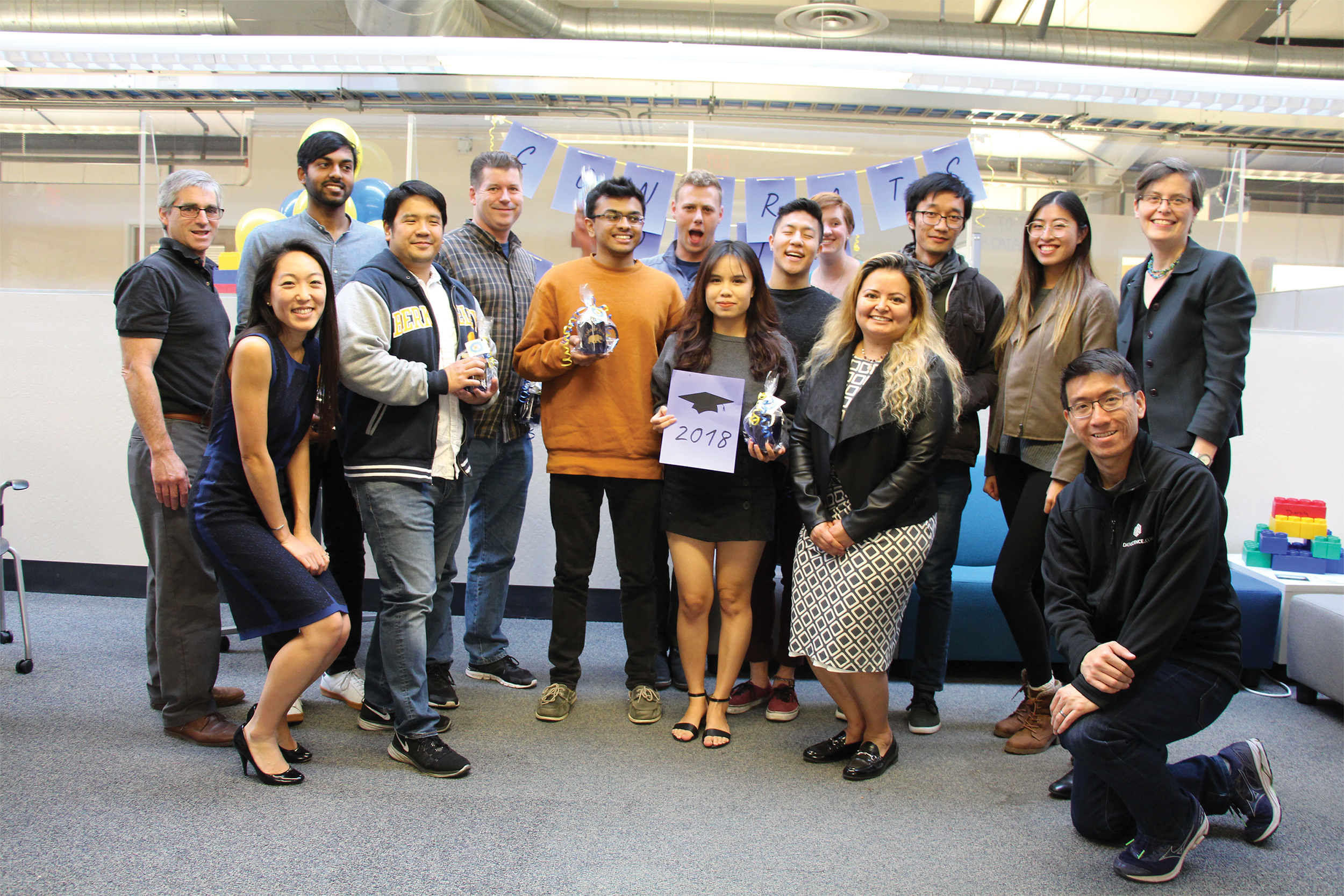
The first class of nine students majoring in data science, pictured with proud faculty and staff.
The major is built upon a foundation of computer science, statistics, and mathematics. It also requires each student to choose a subject specialty, such as economics, robotics, or data arts and humanities, and to take at least one course focused on the human, social, and ethical contexts of data.
History professor Cathryn Carson, who leads the Data Science Education Program, says students spurred the university to create the major. “We knew that something real was going on in the outside world that students were the signal of,” she says. Students are also running workshops and industry events, helping to attract peers who might not feel welcome in technical fields, and working with faculty to build “modules,” innovative lessons that give them hands-on experience with datasets.
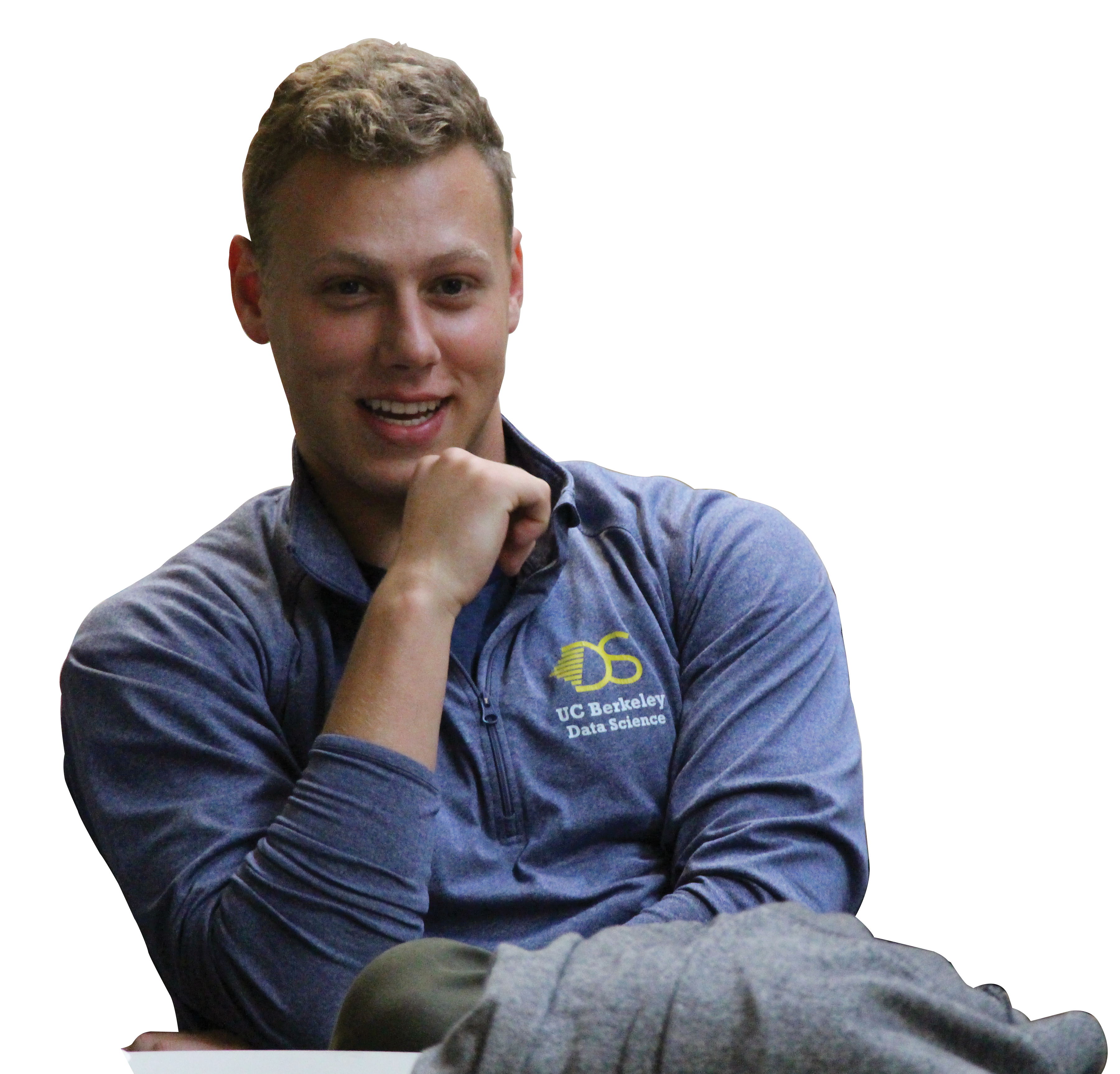
Alexander Ivanoff ’18
Alexander Ivanoff ’18, among the major’s first graduating class, was part of a module team that developed software for analyzing ancient Sumerian texts, unveiling clues about which characters were important and how they related. The team visited the Hearst Museum of Anthropology.
“We got to literally hold ancient Sumerian clay tablets to connect on that next level with what they are doing,” says Ivanoff. “They showed me just how versatile data science tools were.”
These new programs are part of a revolutionary campuswide effort to respond directly to the profound and growing impact of data and computing. Just this fall, Berkeley launched a division offering new courses, degrees, and initiatives that will tackle the research opportunities arising from data science, as well as its sweeping impacts.
You belong here: Intellectual community key to discovery
As a first-generation student who was both transferring and re-entering schools later in life, Bria Tennyson ’20 didn’t think she was “Berkeley material.” She set low expectations for success and imagined herself alone in the library, withdrawn from her mostly younger peers.
That changed quickly when she attended her first gathering for Berkeley Connect, a program in which graduate students mentor undergraduates in several ways. “They handed out stickers that said, ‘You belong here,’ and that resonated with me so strongly,” Tennyson says. “It helped nurture my confidence and gave me the opportunity to engage in and enjoy the experience of Berkeley.”
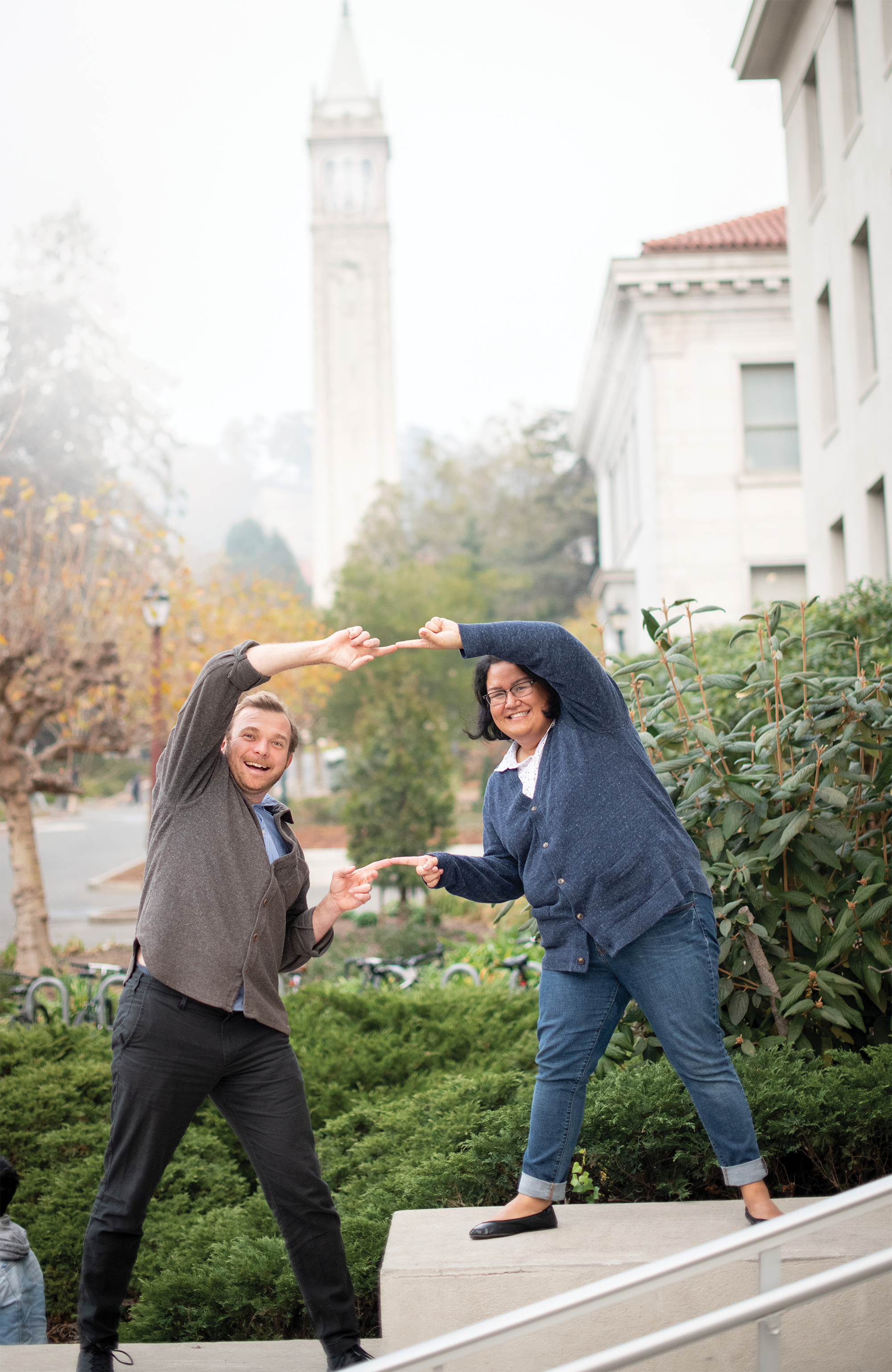
Berkeley Connect graduate student mentor Krzysztof Odyniec with undergraduate participant Bria Tennyson ’19. Photo: Keegan Houser
Berkeley Connect was built on the belief that a sense of belonging and intellectual community are crucial stepping stones on the path to academic achievement. Begun in the English department in 2010, it is now rooted in 13 departments, including architecture, music, and physics, and serves up to 1,500 students per semester. Students participate in one-on-one advising sessions with their personal mentors, small-group discussions related to specific majors, and opportunities for networking and exploring campus. In return for their service as mentors, graduate students receive yearlong fellowships.
In a 2017−18 exit survey of Berkeley Connect participants, 96% said they would recommend the program to a friend, 95% became more aware of available resources, and 90% felt a greater sense of belonging at Berkeley.
Tennyson, a history major, says her mentor, Krzysztof Odyniec ’01, Ph.D. ’17, is like the older brother she never had. Besides encouraging her to overcome her timidity and meet the professor who inspired her interest in postwar Europe, he motivated her to get involved in several organizations and consider various options for her future. She hopes to teach at a community college like the one she attended.
“Our mentors go above and beyond,” she says. “They’re really attuned to [the fact] that we’re young minds in a transition in life when we’re going to be making choices.”
Tennyson’s grandmother, whom she grew up with and took care of for 10 years, died recently. Caretaking, her “other higher education,” taught her that she still has time to live life to its fullest. “She was the reason I came back to school,” she says.
It was during this period that the unexpected power of Berkeley Connect became clear: Her mentor and friends provided support in her grief — proving that authentic human connections, and not only academic support, help students thrive.
How can Berkeley address critical issues facing the world, not as moonshots we might achieve, but as complex, interdisciplinary challenges we will advance through basic research, knowledge, and service to society? To that end, the strategic plan identifies five signature initiatives touching on health, inequality, inclusive intelligence, democracy, and environmental sustainability and justice that will guide our research for the next decade.
Ahead of the curve on climate change
More than 8,000 miles separate San Francisco Bay from West Antarctica, but the future of both places is intertwined. At Berkeley, a broad range of researchers are already anticipating the future under a shifting climate.
The initiative focused on environmental sustainability and justice will harness the campus’s disciplinary strengths and its intellectual partnership with Lawrence Berkeley National Laboratory (LBNL) to counter 21st-century societal challenges. “Berkeley is no ivory tower,” insists Vice Chancellor for Research Randy Katz. “The faculty is very motivated by having impact in the real world.”
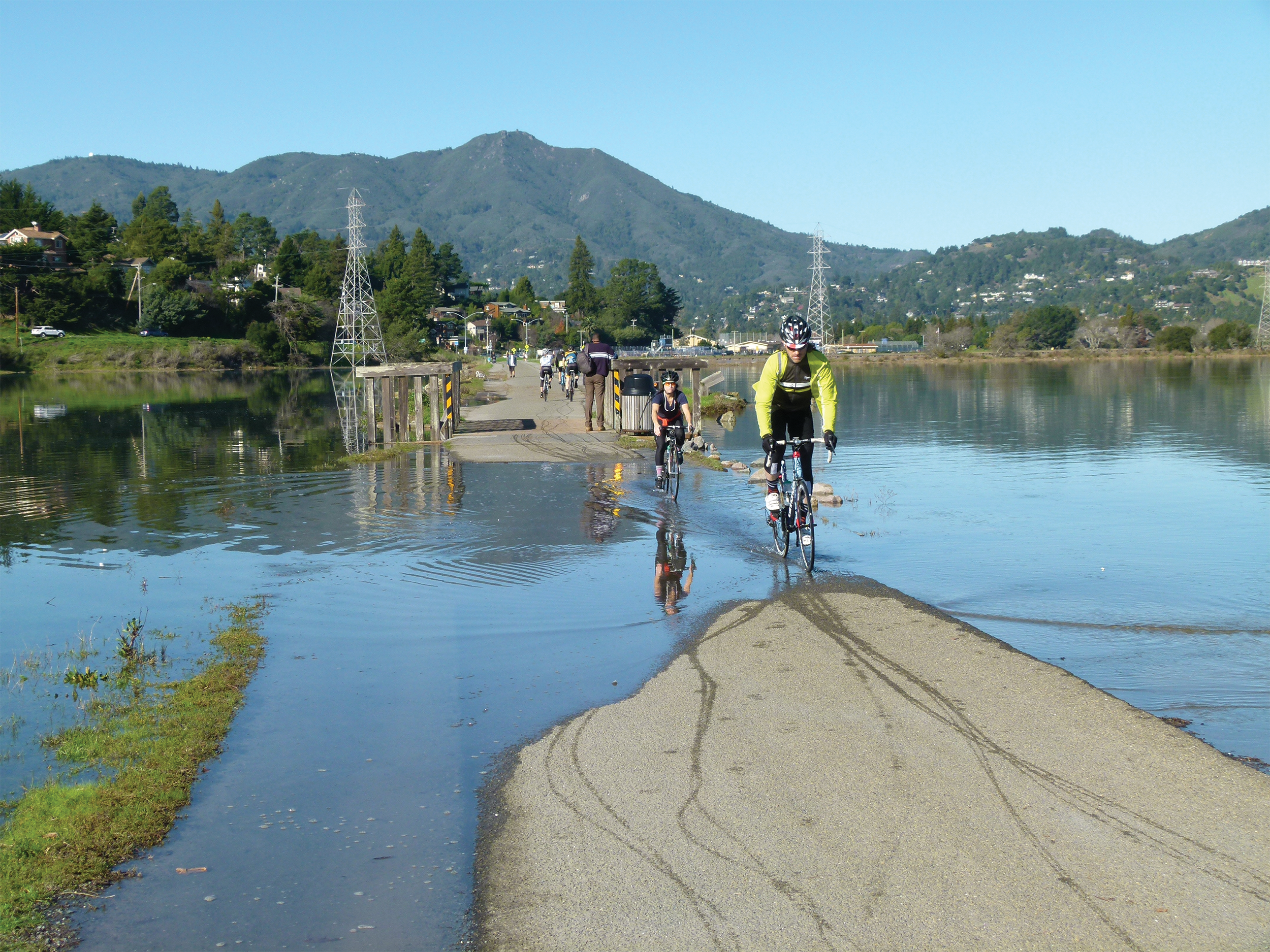
Marin County bike path floods at high tide. Photo: Jeff Poskanzer
For example, says Katz, “If we can’t mitigate climate change, how do we prepare for climate change in the way that we organize society?” Determining adaptations for rising sea levels will be a big part of readying coastal communities, and Berkeley experts have begun considering what to expect as the shoreline begins its inevitable submergence into the San Francisco Bay.
With 90 percent of global ice mass, Antarctica figures as the biggest — and most uncertain — factor in assessing future sea levels. LBNL mathematician Dan Martin Ph.D. ’98 applies a computational tool called adaptive mesh refinement (AMR) to model in unprecedented detail the contours of immense ice sheets that blanket the southern continent. In the same way that more pixels sharpen a digital photo, AMR maximizes resolution by concentrating supercomputing power on specific spots — in this case, those sections of the Antarctic Ice Sheet that are changing most rapidly.

Visualization of changing ice sheets in Antarctica.
Visualizations created by Martin and international colleagues, such as the one above, reveal how ice sheets change under simulated scenarios of varying climatic conditions. “Ice looks like it’s just sitting there, but it’s flowing and changing,” says Martin, who knows how dynamic frozen water can be. Antarctic ice flows to the sea in relatively fast-moving ice streams, eventually forming large floating ice shelves at the coast. Incursions of warm ocean water can melt and weaken these ice shelves from below. Eventually, they break apart, leading to faster ice flow, which in turn leads to ice thinning and retreat. In the worst-case simulation scenario — which Martin and climate scientists consider to be extremely unlikely — Antarctic ice could contribute more than three feet of sea level rise within the next century and a total of 12 feet over 500 years. “Global sea levels don’t go up uniformly, like in a bathtub,” says Martin. Water released from Antarctic ice will flow mainly toward the equator and middle latitudes, bringing us back to San Francisco Bay.
Around the Bay, sea level has risen by more than 8 inches in the last 100 years, according to California’s Fourth Climate Change Assessment (CCCA4). Released in August, CCCA4 reviews current research and recommends resilient actions for nine regions around the state. Mark Stacey, Henry and Joyce Miedema Chair in Civil and Environmental Engineering, is one of 12 Berkeley authors on the summary report for the San Francisco Bay Area.
“The Bay Area is highly engaged in this, but it’s a real hard problem,” says Stacey. “It’s extremely expensive to get to a resilient end point.” Underscoring his research projects around adaptation to increasing water levels and more frequent storm surges is the importance of regional interdependence and long- term community collaboration to reach solutions.
With colleagues at UC Davis, NYU, and the U.S. Geological Survey, Stacey co-led a project in which the team assessed how vulnerable Bay Area infrastructure, including airports, highways, railways, and sewage treatment plants, would be to sea rise. Their analysis reveals that interventions to restrict flooding locally can alter flood patterns throughout the region, for better or worse. The most extensive effect emanates from shoreline changes in the South Bay. “Communities throughout the region have a stake in what happens at the bay’s edge,” Stacey says.
Stacey has begun talking to county-level stakeholders around the Bay to encourage coordinated adaptation efforts. He hopes to avoid communities choosing the short-term solution of fortifying themselves behind levees lying below sea level, as in New Orleans.
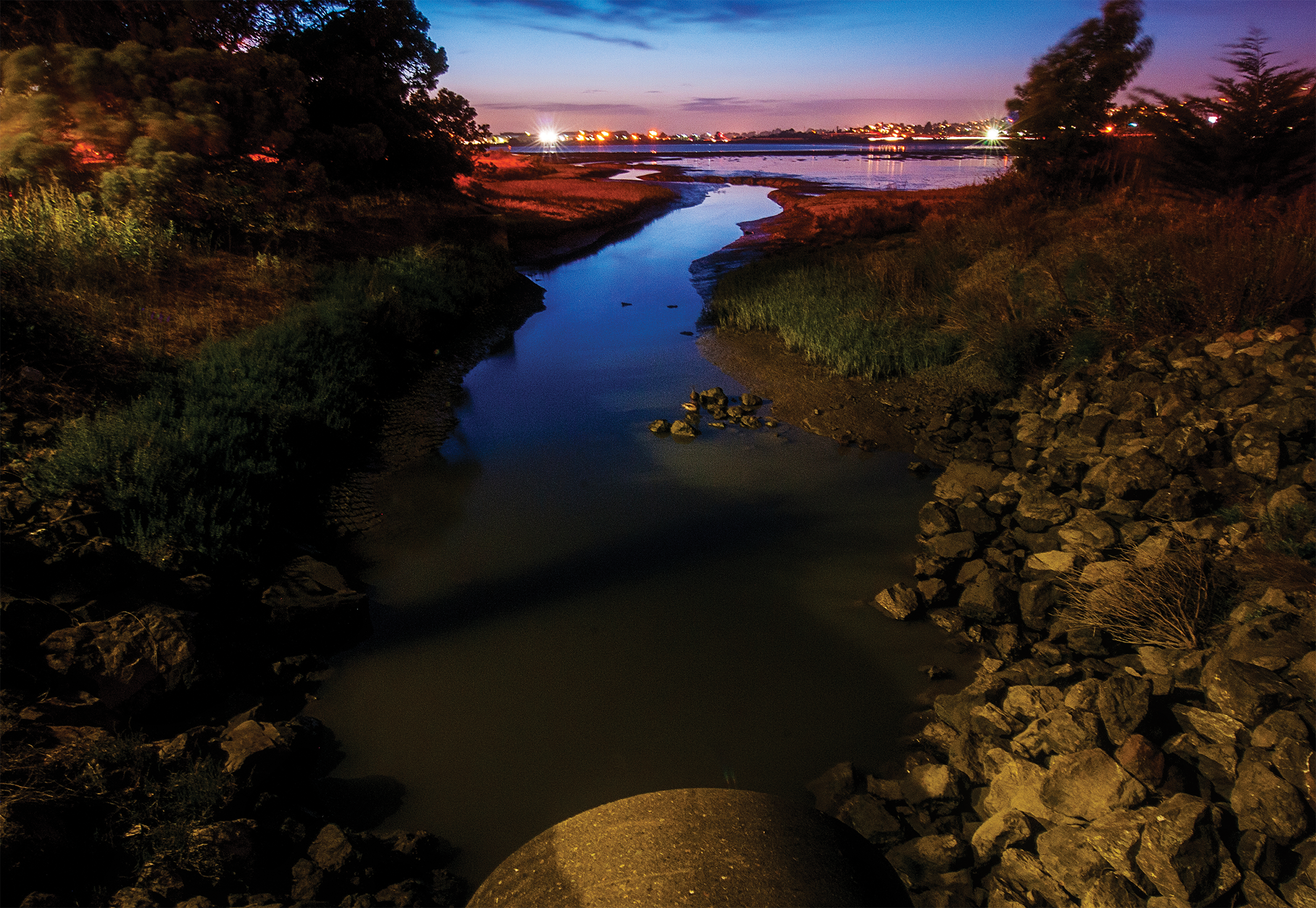
McLaughlin Eastshore State Park. Photo: Keegan Houser
“I’m very anti-wall,” says Kristina Hill, associate professor in the College of Environmental Design. Hill studies resilient design solutions from around the world to see what could work around the San Francisco Bay to protect economic and natural assets. Rather than relying solely on static seawalls or levees, Hill favors a broad approach to shoring up the bay shore that incorporates dynamic landforms such as beaches, dunes, or marshes. These could control floods while providing space for recreation and habitat for other species. They could also be cheaper to construct and easier to make higher or wider as conditions change.
“We’ve never tried to design and manage cities during a period of rapid sea level rise,” says Hill. “That’s what we have to do now.”
Ecologist David Ackerly, dean of the College of Natural Resources and coordinating author of CCCA4’s Bay Area report, says “California is a leader on [greenhouse gas] emissions reduction. We need to lead on adaptation as well, to minimize impacts to biodiversity and people… especially for frontline communities who will bear the brunt of these changes.” Count on Berkeley for continuing to provide its share of leadership and innovative ideas in response to the changes ahead.
As a public university, Berkeley has always sought to accept and represent the full range of our state’s diverse population. No single ethnic group can claim a majority in California. And as its demographics evolve — about 25 percent of current high school graduates are of Hispanic descent — so too will Berkeley’s, with the goal to become a Hispanic-Serving Institution in the next decade. But accepting a full spectrum of diversity is just the beginning. We’re working to create an inclusive, accessible environment for all abilities, genders, and cultural backgrounds — fostering equity for everyone.
Universal locker room a first among California colleges
Go to the gym. Work out. Take a shower and change. For many Berkeley students, it’s a simple proposition. But for others, it’s the worst part of their day — or impossible altogether.
Ben Perez ’13, manager of Campus Access Services, says he felt mortified sharing a residence hall bathroom and showers with 25 other students during his first year at Berkeley in 2007. He has used a wheelchair, including a special one for bathing, since incurring a spinal cord injury at age 16. “My disability life had been a private thing,” he says. “I would have valued a little bit of space to learn how to be comfortable with myself.”
Juniperangelica Cordova ’19, an ethnic studies major who is transgender, shared Perez’s apprehension and felt anxious about going to the gym. “I like to work out, but I’d often avoid the locker room and go home with dirty clothes, or not go to prompt stares or harassment,” she says.
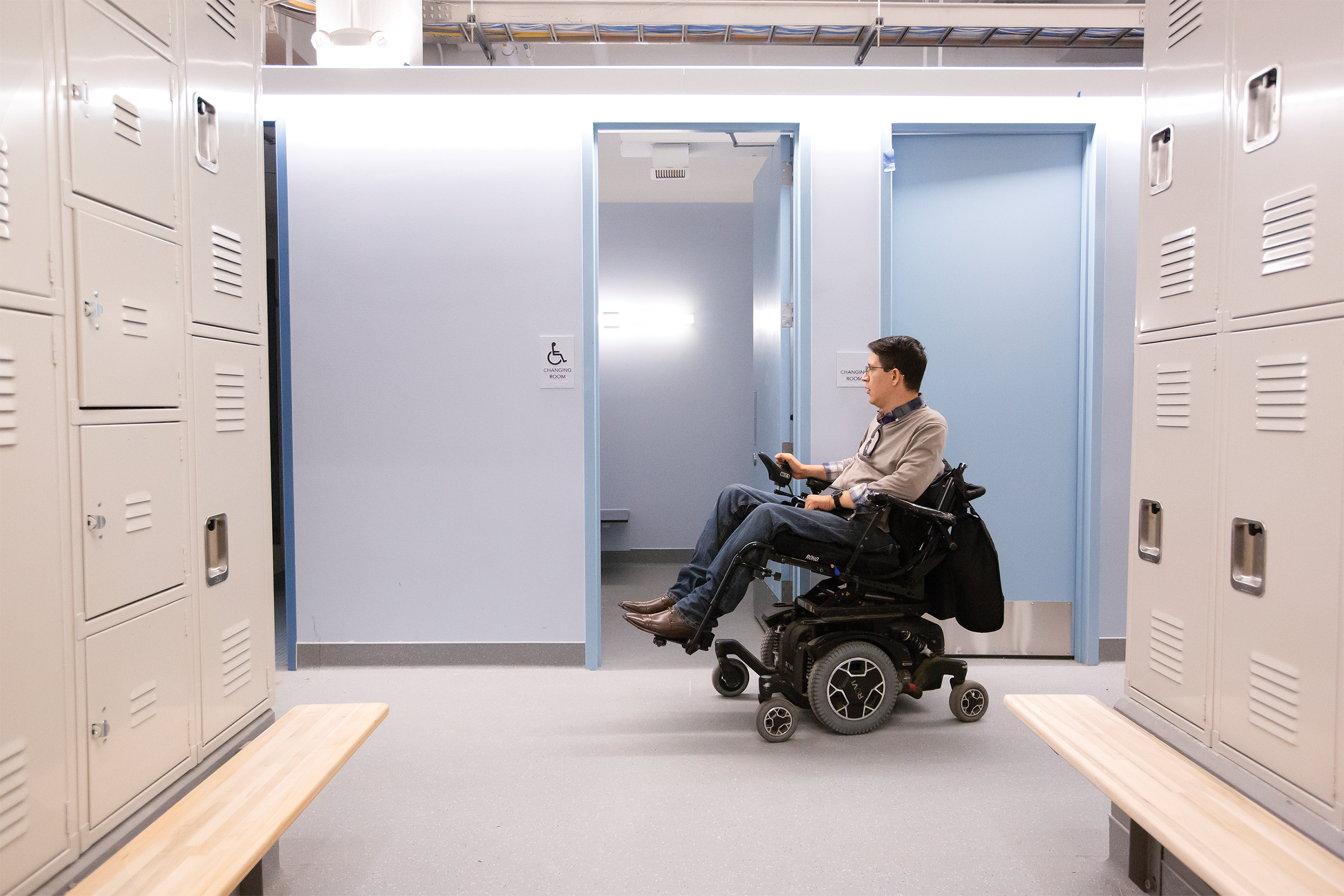
Ben Perez ’13, manager of Campus Access Services, explores the new universal locker room. Photo: Brittany Hosea-Small
That all changed last fall when the Recreational Sports Facility opened a universal locker room — the first such large-scale collegiate facility in California and one of just a few in the nation — for students desiring more privacy, including those who are transgender, non-binary, or have disabilities or body-image struggles. Located between the men’s and women’s locker rooms, the new 4,500-square-foot structure has its own entrance, 400 lockers, 16 individual changing rooms, 7 private showers, 5 private toilets, and 4 shared sinks. It also leads to Spieker Pool, which some students have avoided in the past because it was only accessible through the traditional locker rooms.
In a bold move to help create a welcoming environment, Berkeley students voted in 2015 to add an annual fee for “new, innovative mind-body services” that “address the concerning rise of mental health complications on campus and provide new support for minority student groups.” Those fees went into a wellness fund, and an advisory committee later voted to use money from the fund for the locker room. Thus far, the fund has also covered counseling services, medical care for student survivors of sexual violence, and a pilot program for emergency housing.
“Our social fabric contains a really specific and narrow vision of what someone who goes to a gym should look like,” says Martha Velasquez, associate director of the Disabled Students’ Program. She says the new locker room may welcome individuals who are on the spectrum, have PTSD or other psychological disabilities, or have a sensory disability and need a more private space to change.
“Any moment in which the university identifies and proactively moves an access barrier to make spaces more inclusive is a big moment,” Perez says.
Creating a culture of wellness
For many Berkeley students, getting admitted to Cal is just the first hurdle. On top of studying to compete at this top university — and often working at least one job — these students must also make tough decisions about how often they’ll be able to eat, or where they’ll be sleeping each night.
According to two recent surveys, 39 percent of undergraduate students (11,430) and 23 percent of graduate students (2,498) experience food insecurity. A third survey conducted by the chancellor’s housing task force confirmed that 10 percent of all students self-report being homeless at some point in the academic year.
Compared to its peers around the country, Berkeley is ahead of the curve with research data and model programs and services that address basic needs. Last year we served more than 5,000 students — but we can do much better. In 2019, the university will launch a centralized Basic Needs Center in the MLK, Jr. Student Union, and Kiyoko Thomas will organize the collective efforts.
Thomas, who has always worked to improve systems for individuals and communities, hopes to create awareness around how economic, food, and housing challenges can negatively affect mental health. “The chancellor’s priority for creating a healthy campus climate aligns with my efforts,” she says, “in that they work toward creating a culture of wellness that’s inclusive of both physical and mental health.” In fact, the UC Berkeley Foundation Board of Trustees issued a challenge to reach 10,000 gifts during Big Give, Cal’s annual online fundraising event in March. It will donate $100,000 to a basic needs fund if the challenge is met.
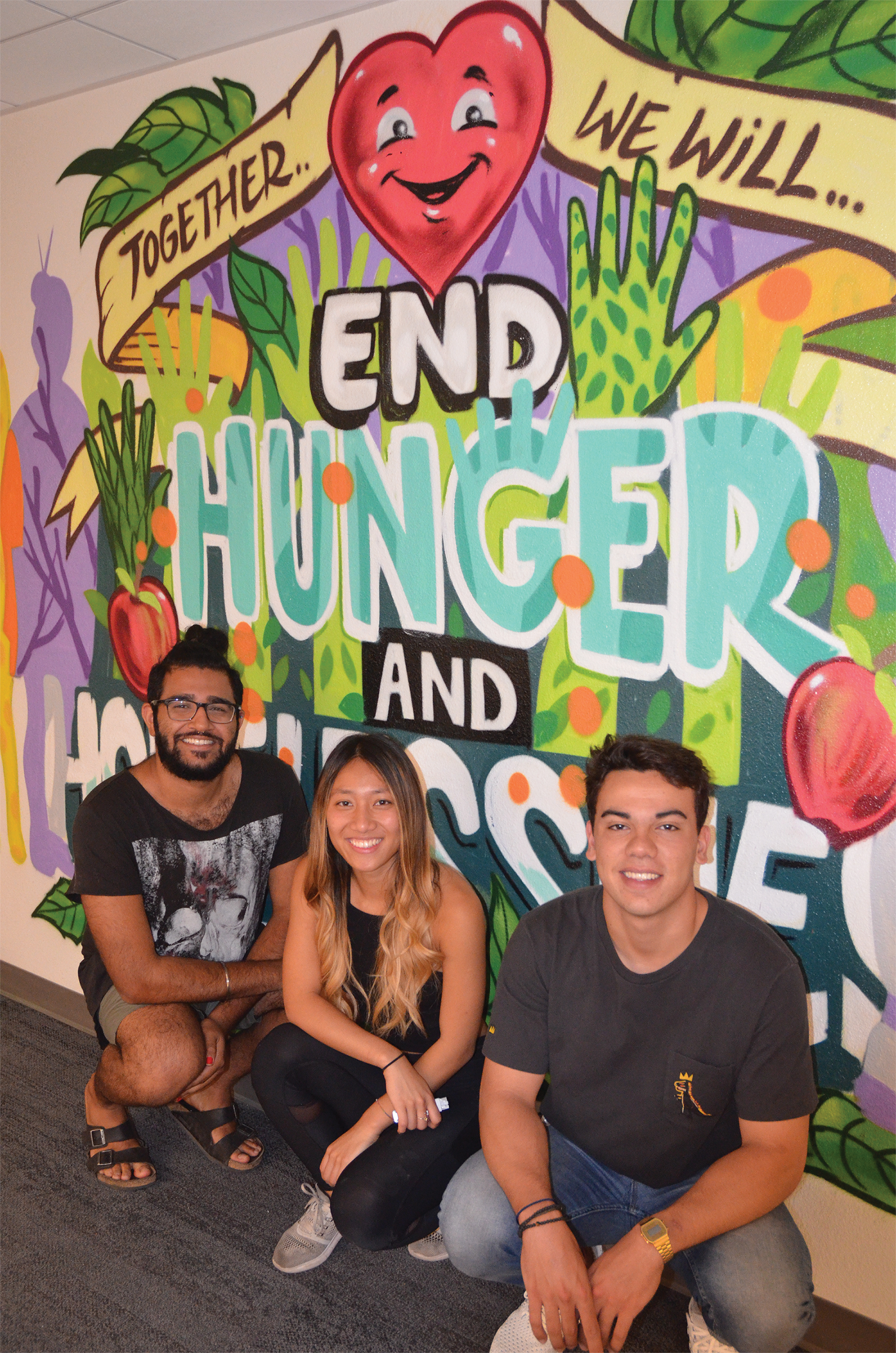
Vikrem Padda ’19, CalFresh campus coordinator, and basic needs security food systems co-coordinators Stella Zhu ’19 and Ibrahim Menendez. Photo: Gretchen Kell
In addition to addressing student food and housing, the Basic Needs Center will host events, presentations, skills trainings, and a community kitchen. Supporting these efforts are student coordinators such as Berkeley junior Sara Tsai ’20. Many of her coworkers are also clients, she observes. It’s not uncommon for them to have to skip class because they can’t get the course schedules they need, while working jobs to pay for the tuition of the classes they now can’t attend. This vicious cycle is one factor the chancellor’s strategic plan hopes to remedy.
“Often the narrative around total cost of college attendance is focused on tuition and fees, when the most costly aspect of attending a university is housing, utilities, and food,” Tsai explains. “This is especially true in the Bay Area, where Berkeley is ranked the most expensive college town in the nation.”
The commitment of students like Tsai helps to make the program such a success, says Thomas. “Since I’ve been at Cal, I’ve met an entire community of full-time students who have demonstrated incredible leadership around this work,” she says.

